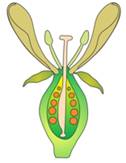Class 11-science NCERT Solutions Biology Chapter 5 - Morphology of Flowering Plants
Morphology of Flowering Plants Exercise 70
Solution 1
|
Pinnately Compound Leaf |
Palmately Compound Leaf |
|
|
Solution 2
Phyllotaxy is the pattern of arrangement of leaves on the stem or branch. This is of three types-alternate, opposite and whorled.
i. Alternate arrangement of leaves: In alternate type of phyllotaxy, a single leaf arises at each node in an alternate manner. Examples: Hibiscus, mango, peepal
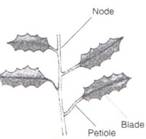
ii. Opposite arrangement of leaves: In opposite type of phyllotaxy, a pair of leaves arises at each node and lies opposite to each other. Examples: Tulsi, guava

iii. Whorled arrangement of leaves: If more than two leaves arise at a node and form a whorl, it is called whorled arrangement of leaves. Example: Alstonia

Solution 3
a) Aestivation: The arrangement of accessory floral organs (sepals or petals) in relation to one another in the bud condition is known as aestivation. The main types of aestivation are valvate, twisted, imbricate and vexillary.
- Valvate: When sepals or petals in a whorl just touch one another at the margin, without overlapping, it is said to be valvate. Example: Calotropis
- Twisted: If one margin of the appendage overlaps that of the next one and so on, it is called twisted. Twisting may either be clockwise or anticlockwise. Examples: China rose, lady's finger, cotton
- Imbricate: If the margins of sepals or petals overlap one another but not in any particular direction as in Cassia and gulmohar, then the aestivation is called imbricate.
- Vexillary: In pea and bean flowers, there are five petals, the largest (standard) overlaps the two lateral petals (wings) which in turn overlap the two smallest anterior petals (keel); this type of aestivation is known as vexillary or papilionaceous.
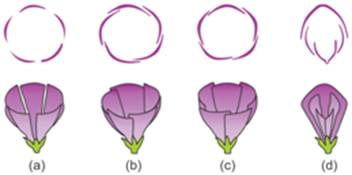
b) Placentation: The distribution of placentae or ovule bearing cushions inside the ovary is known as placentation. The placentation is of different types-marginal, axile, parietal, basal, central and free central.
- Marginal: In marginal placentation, the placenta forms a ridge along the ventral suture of the ovary and the ovules are borne on this ridge forming two rows. Example: Pea

- Axile: When the placenta is axial and the ovules are attached to it in a multilocular ovary, the placentation is said to be axile. Examples: China rose, tomato, lemon

- Parietal: In parietal placentation, the ovules develop on the inner wall of the ovary or on the peripheral part. The ovary is one-chambered, but it becomes two-chambered due to the formation of a false septum. Examples: Mustard, Argemone
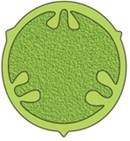
- Free central: When the ovules are borne on the central axis and septa are absent, the placentation is called free central. Examples: Dianthus, Primrose
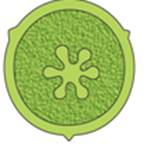
- Basal: In basal placentation, the placenta develops at the base of the ovary and a single ovule is attached to it. Examples: Sunflower, marigold
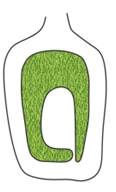
c) Actinomorphic: It is a flower which can be divided into two equal vertical halves by any vertical plane. Examples: Mustard, Datura, chilli
d) Zygomorphic: It is a flower which can be divided into two equal vertical halves by only one plane and has bilateral symmetry. Examples: Pea, gulmohar, bean
e) Superior ovary or hypogynous flower: In the hypogynous flower, the upper part of the thalamus is slightly swollen and forms a cushion-like disc. The gynoecium occupies the highest position, while the other parts are situated below it. The ovary in such flowers is said to be superior. Examples: Mustard, china rose, brinjal
f) Perigynous flower: If the gynoecium is situated in the centre and other parts of the flower are located on the rim of the thalamus almost at the same level, it is called perigynous. The ovary is said to be half inferior. Examples: Plum, rose, peach
g) Epipetalous stamen: It is a stamen which is borne over a petal instead of being inserted directly over the thalamus. Example: Brinjal
Solution 4
(a) Racemose and cymose inflorescences:
|
Racemose |
Cymose |
|
|
(b) Apocarpous and syncarpous ovaries:
|
Apocarpous ovary |
Syncarpous ovary |
|
Apocarpous ovary means two or more carpels which are free. Examples: Lotus, rose |
The syncarpous ovary means two or more carpels which are fused. Examples: Mustard, tomato |
Solution 5
i. Gram seed:
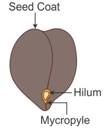
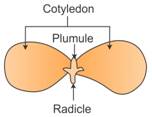
ii. V.S. of maize seed:

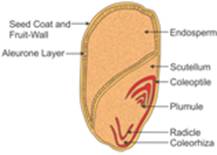
Solution 6
i. Solanaceae
It is a large family, commonly called as the 'potato family'. It is widely distributed in tropics, subtropics and even temperate zones.
Vegetative characters:
Plants are mostly herbs, shrubs and small trees.
Stem: Herbaceous, rarely woody, aerial; erect, cylindrical, branched, solid or hollow, hairy or glabrous, underground stem in potato (Solanum tuberosum)
Leaves: Alternate, simple, rarely pinnately compound, exstipulate; venation reticulate
Floral Characters:
Inflorescence: Solitary, axillary or cymose as in Solanum
Flower: Bisexual, actinomorphic
Calyx: Sepals five, united, persistent, valvate aestivation
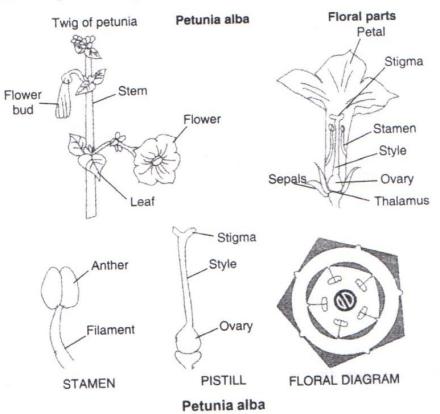
Corolla: Petals five, united; valvate aestivation
Androecium: Stamens five, epipetalous
Gynoecium: Bicarpellary, syncarpous; ovary superior, bilocular; placenta swollen with many ovules
Fruits: Berry or capsule
Seeds: Many, endospermous
Floral Formula: ![]()
Economic importance:
Many plants belonging to this family are sources of food (tomato, brinjal, potato), spice (chilli); medicine (belladonna, ashwagandha); fumigatory (tobacco) and ornamentals (petunia).
Solution 7
Placentation: The distribution of placentae or ovule bearing cushions inside the ovary is known as placentation. The placentation is of different types-marginal, axile, parietal, basal, central and free central.
i. Marginal: In marginal placentation, a monocarpellary unilocular ovary bears ovules longitudinally along the ventral suture in one or two alternate rows. Example: Pea

ii. Axile: In axile placentation, a syncarpous bilocular to multilocular ovary bears ovules on the central axile column where the septa meet. Examples: China rose, tomato, lemon

iii. Parietal: In parietal placentation, a syncarpous, unilocular ovary bears two or more placentae longitudinally along the wall. The ovary is one-chambered, but it becomes two-chambered due to the formation of a false septum. Examples: Mustard, Argemone
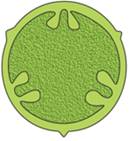
iv. Free central: In free central placentation, polycarpellary syncarpous but unilocular ovary bears locules around the central column which is not connected to the ovary wall. Examples: Dianthus, Primrose
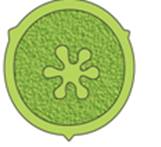
v. Basal: When a unilocular ovary bears a single ovule from the basal region, it is called basal placentation. Examples: Sunflower, marigold

Solution 8
A flower is a condensed shoot which is specialised to take part in sexual reproduction of angiosperms. A typical flower has four different kinds of whorls arranged successively on the swollen end of the stalk or pedicel, called thalamus or receptacle. These are calyx, corolla, androecium and gynoecium. Calyx and corolla are accessory organs, while androecium and gynoecium are reproductive organs. In some flowers such as lily, the calyx and corolla are not distinct and are termed as perianth.
Parts of a flower:
Each flower normally has four floral whorls-calyx, corolla, androecium and gynoecium.
i. Calyx: The calyx is the outermost and the lowermost whorl of the flower. It consists of sepals which are green and leaf like. The major function of sepals is protection and support to other floral organs.

ii. Corolla: Corolla is composed of petals which are brightly coloured flat leaf-like floral organs and lie inner to sepals and outside the stamens. Their function is to attract insects for pollination.
iii. Androecium: The androecium is composed of stamens. Each stamen which represents the male reproductive organ consists of a stalk or a filament and an anther. Each anther is usually bilobed and each lobe has two chambers, the pollen sacs. The pollen grains are produced in pollen sacs. The stamens of the flower may be united with other members such as petals or among themselves.
iv. Gynoecium: The gynoecium is the female reproductive part of the flower and is made up of one or more carpels. A carpel consists of three parts, namely stigma, style and ovary. The ovary is the enlarged basal part, on which lies the elongated tube, the style. The style connects the ovary to the stigma. The stigma is usually at the tip of the style and is the receptive surface for pollen grains. Each ovary bears one or more ovules attached to a flattened, cushion-like placenta. When more than one carpel is present, they may be free (as in lotus and rose) and are called apocarpous. They are termed syncarpous when carpels are fused, as in mustard and tomato. After fertilisation, the ovules develop into seeds and the ovary matures into a fruit.
Solution 9
The arrangement of flowers on the floral axis is termed as inflorescence. Depending on whether the apex gets converted into a flower or continues to grow, the two major types of inflorescences are defined as racemose and cymose.
i. Racemose inflorescence: In the racemose type of inflorescence, the main axis continues to grow. The flowers are borne laterally in acropetal succession which means that older flowers are at the base and younger flowers are near the apex.

ii. Cymose inflorescence: In the cymose type of inflorescence, the main axis terminates in a flower; hence, the growth is limited. The flowers are borne in a basipetal order where the older flowers are at the apex and the younger flowers are near the base.

Solution 10
There are three types of arrangement of floral members in relation to their insertion on the thalamus:
i. Hypogynous flower: In hypogynous flowers, the ovary lies over the tip of a conical or convex thalamus, while stamens, petals and sepals lie successively below it. The ovary is superior, while all other floral organs are inferior.
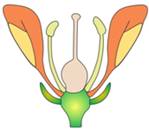
ii. Perigynous flower: In perigynous flowers, the thalamus is expanded on the periphery to become disc-like or flask-shaped. The ovary lies in the centre but is not fused with the thalamus. The ovary can be considered superior or half-inferior.

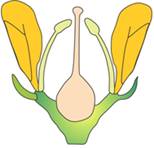
iii. Epigynous flower: In epigynous flowers, the ovary is embedded in the thalamus. Only style and stigma are observable. The ovary is inferior, while all other parts are superior. Example: Sun flower
